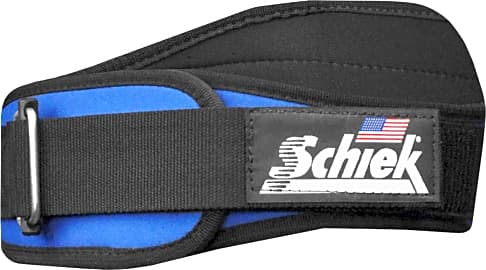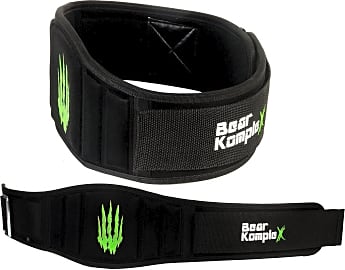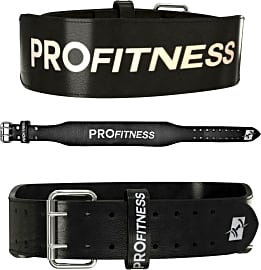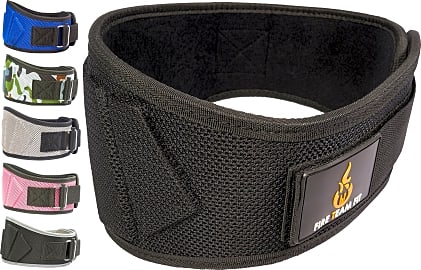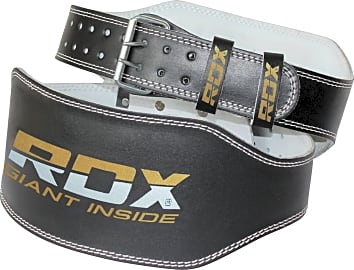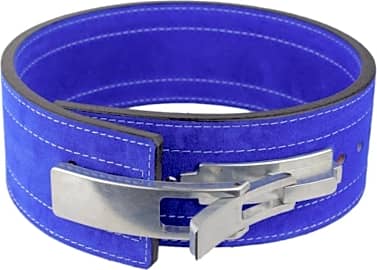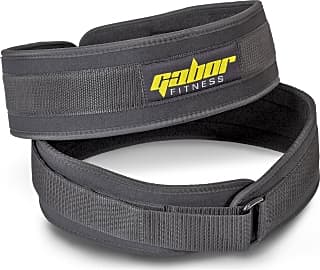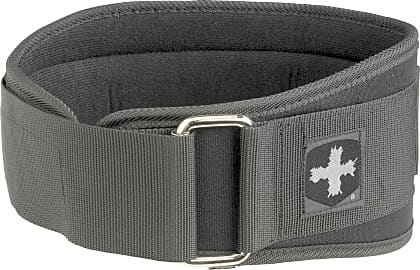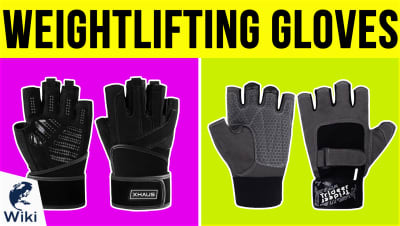The 10 Best Lifting Belts

This wiki has been updated 43 times since it was first published in September of 2015. Whether you use weights for basic body sculpting, serious strength training, or to get ready for competitions, make sure you stabilize your back muscles and torso to prevent injury and strain. A durable lifting belt will help minimize the risk of spinal flexion, allowing for a better biomechanical position, and will give you the support needed to maximize your efforts. When users buy our independently chosen editorial selections, we may earn commissions to help fund the Wiki.
Editor's Notes
May 26, 2021:
Our top choice remains the Dark Iron Fitness Pro, which is especially well-built and does the best job of minimizing injury risk. For something a bit less expensive, the Harbinger Ultralight is a great choice, but you'll probably need to order one size bigger than it seems at first. For lighter workouts, the relatively slim Gabor Fitness Epic Performance 4ILPBLT is also a good option, although it's not stiff enough for very heavy lifting. If you like to go heavy on the core workouts, consider the ProFitness Genuine Leather because its tapered design allows for a slightly better range of motion than others.
March 02, 2020:
When it comes to weight lifting belts, you generally have two options — leather or synthetic. Leather models, like the Dark Iron Fitness Pro, ProFitness Genuine Leather, RDX Cowhide WBS-4RB, and Inzer Advance are going to be thicker and more rigid than synthetic belts. This makes them best suited to powerlifters since they provide the most stability. However, they are going to be more difficult to clean, as the leather material can absorb sweat and will be difficult to clean. They can often be uncomfortably stiff at first until they are broken in, too.
In addition to having a stiffer form, leather belts usually have a more secure closure system, as can be seen in the two-prong buckles of the Dark Iron Fitness Pro, ProFitness Genuine Leather, and RDX Cowhide WBS-4RB. Unlike with the Velcro found on synthetic models, there is no chance of these wearing out and losing stickiness over time. If you think dealing with a pronged belt buckle may get annoying after a while, when all you want to do is start squeezing out some deadlifts while you are nice and warm, you may like the quick-release buckle on the Inzer Advance. While getting the initial fit may be more time consuming, once you have that dialed in, you should be able to don and doff it in seconds.
On the opposite side of the spectrum, we have synthetic belts like the Rip Toned 4.5-Inch, Schiek Nylon Model 2004, Bear Komplex Low-Profile, Fire Team Fit Olympic, Gabor Fitness Epic Performance 4ILPBLT, and Harbinger Ultralight 23310. These will be easier to clean, generally more affordable, and better for functional training, such as Crossfit. For example, the Rip Toned 4.5-Inch is actually machine washable, so you won't have to worry about it building up with a funky odor because you can't get it clean enough. Of all the synthetic models on our list, the Bear Komplex Low-Profile may be the best for heavy lifting. Its six-inch width at the lumbar region should offer plenty of support and its Velcro is known to hold up to lots of use. On the other hand, if you only go to the gym or engage in Crossfit a couple of times a week, don't put forth a lot of intensity, and are a more casual lifter, you may be able to get away with the budget-friendly Gabor Fitness Epic Performance 4ILPBLT. This can help you save a little money for a decent pair of weightlifing or Crossfit gloves, too.
Special Honors
Rogue Fitness Ohio Handcrafted from vegetable-tanned American leather that measures 10 millimeters thick, the Rogue Fitness Ohio is a competition-level belt that offers a high level of support. Though it features a single-prong buckle, that buckle is made from thick metal, so the chances of it every failing are slim. Plus, this design makes it easier to don quickly than two-prong models. roguefitness.co
Gymreapers Lever Belt If you care as much about style as function, you'll probably want the Gymreapers Lever Belt. It proudly displays the company's name and skull logo, so onlookers know you take your gym equipment seriously, and is crafted from 10-millimeter thick leather. Its lever-style buckle offers a secure closure too, so it shouldn't pop open no matter how hard you strain against it. gymreapers.com
Choosing Your Lifting Belt
If you have spent much time in and around gyms where people are lifting weights, you have likely seen your share of lifting belts.
If you have spent much time in and around gyms where people are lifting weights, you have likely seen your share of lifting belts. These are the broad, rugged bands that weightlifters often wear wrapped around the lower torso while completing squat lifts, military presses, and other exercises. Just as a support brace can help protect a person's spine and lower back when he or she is lifting heavy loads at work or at home, a lifting belt protects the body during the use of heavy weights, reducing the chance of injury and helping to maintain proper form.
Traditional lifting belts were made out of leather -- usually several strips layered over one another, in fact -- and featured a large metal buckle with multiple adjustments made possible by pre-formed holes. It is still easy to find many weightlifting belts in just this style, and for many athletes the classic approach will serve best. Leather's inherent strength and rigidity allows these belts to offer plenty of support to the wearer's core and spine, though they can be less comfortable than more flexible options made using different materials and featuring more ergonomic shapes.
Many modern lifting belts are designed to follow the natural curves and contours of the human body, with a shape that is slender above the hips, broad across the middle of the back, and that can be easily adjusted across the belly. Materials such as neoprene and nylon offer more flexibility than leather, while belts that secure using hook-and-loop closure (frequently referred to by the brand name Velcro) offer a more customizable fit. Some lifting belts feature built in layers of padding and/or are made from materials that offer excellent moisture wicking properties and breathability, both of which are ideal for wearing as you sweat your way through a workout.
All of that said a more supple, more comfortable lifting belt might not be your best choice; lifting belts are not designed to be worn for extended periods of time, and frankly their primary purpose is not comfort, but rather safety and support. A thick, rigid belt that is not all that comfortable but which holds your body in proper posture during a power lift is a better choice than a softer belt you practically forget you are wearing.
Basic Safe Weight Lifting Techniques
A weight belt is only intended for use during standing exercises such as deadlifts or squats. If you are engaged in any other form of workout, even one that uses a great deal of weight, such as a bench press, you should remove your lifting belt. These units can only create the abdominal and spinal support for which they were designed when you are on your feet, and can in fact cause injury when worn improperly. This is especially true if you are exercising in a manner that rotates or bends the torso, such as riding a bike or doing crunches.
A weight belt is only intended for use during standing exercises such as deadlifts or squats.
These belts should also be removed even for standing exercises wherein you are not nearing your maximum single repetition limit. Using a weight belt when lifting weights light enough that your body can easily support itself without assistance may hamper the development of the very muscles you are targeting. A weight belt can limit the strength development of the lower back in particular; its regular use should be offset by exercises targeting the lat and oblique muscle groups.
In short, remove the belt when you don't need it. But when you are about to complete "maximal" lifts -- a set of low repetition, heavy weight squats, jerks, or barbell rows, for example -- strap on and secure that weight belt before you ever touch a weight.
Proper leg positioning is critical for safe and effective lifting of heavy weights. It's also important that you choose proper footwear. Heavy weightlifting merits the use of shoes with soles that will not compress; eschew the air pocket-filled soles of running shoes for sneakers with solid rubber bottoms, such as Converse or even basic wrestling shoes. The air-filled soles can reduce your stability and lessen the transfer of power from your body to the lift.
Also make sure to keep your torso aligned with your legs and as upright as possible, heeding the old adage to "lift with your legs, not your back." Your head should always be upright and your chest slightly raised.
And though it should go without saying, never attempt to lift more weight than you are certain you can safely manage. It is easy to incur a sudden, serious injury when working out with heavy weights even under safe circumstances; minimize the chance of hurting yourself by keeping the weight within your range of capabilities and, whenever possible, by not working out alone. (Training with a certified instructor can give you the knowledge to exercise safely on your own -- consider investing in several sessions
Other Gear to Aid Proper Lifting
As noted above proper shoes are important for safe and proper weight lifting. That topic brings up little debate in the exercise community. What you should have on your hands, however, is another story entirely. Many "purists" will say that wearing gloves while exercising is a bad idea, as they can reduce the control you have over the weights. Gloves also reduce the buildup of callous that will provide natural grip and protection over time. Ultimately, it is a personal decision whether or not you choose to wear gloves while lifting.
Most such wraps do not cover the palms or fingers, and thus won't inhibit development of callous.
Wrist wraps are generally accepted as a smart accessory. These wraps helps support your wrists and prevent the over-extension injuries that can be caused by lifting heavy free weights. Most such wraps do not cover the palms or fingers, and thus won't inhibit development of callous. Gym chalk can aid your grip primarily by minimizing the moisture (a.k.a. sweat) on your hands while still allowing for a natural feel of metal against skin.
Also don't forget how much strain lifting heavy weights can put on your knees; as you squat beneath hundreds of pounds of weight plates, your knees are subjected to incredible amounts of pressure. Just as a lifting belt can help prevent damage to your back, knee braces can reduce the risk of injuring these critical joints. Consider a compression-style sleeve or an actual solid brace that prevents certain articulations of the knee.



